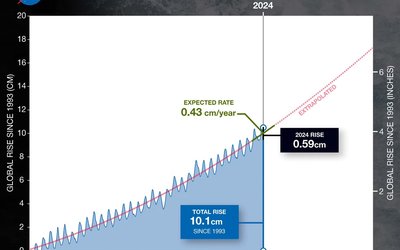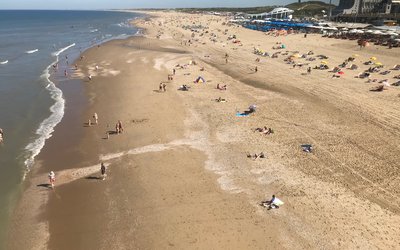Coastal erosion and coastal floods
Current once-in-a-hundred-years flood levels along US coastline may occur every few years by 2050
September 11, 2017

Downtown Miami flooding (photo: Carvalho, www.flickr.com)
Sea level rise will strongly increase the frequency of current high frequency flood levels along the US east coast, according to a recent study. Along the west coast especially current low frequency flood levels will occur far more often. The authors of this study stress the importance of policy makers implementing policy based on the right information on the increase of flood levels. According to them, results presented by the IPCC in their latest assessment report ‘may be seriously misleading’.
Estimates of flood return periods are the base for flood risk management
Flood risk management, including investments in infrastructure, insurance schemes, evacuation procedures, and flood risk communication, is often tied to estimates of flood return periods. The flood level of a 100-year flood at a certain location along the coastline, for instance, is often used as a measure to define where to build houses and how to protect infrastructure, and for strengthening flood defences. Also, insurance companies often fix their insurance premiums on flood probability zoning, and even use this information to decide whether insurance against flooding is offered at all. Projections of future changes (increases) in the frequencies of flood levels that currently occur once-in-a-hundred-years, for instance, are therefore extremely important for a large number of reasons. In the absence of sufficient investments in flood protection, where flood defences are strengthened (raised) timely in line with rising flood levels, flood risk may increase dramatically already in a few decades. This was illustrated for the US coastline by results of a recent study on the amplification of flood frequencies with local sea level rise and emerging flood regimes.
Future flood return periods for the US coastline
The amplification of flood frequencies by sea level rise is expected to become one of the most economically damaging impacts of climate change for many coastal locations. Understanding the magnitude and pattern by which the frequency of current flood levels increase is important for developing more resilient coastal settlements.
This amplification was quantified for the US coastline for projections of relative sea level rise in 2050 and 2100. Relative sea level rise means that sea level rise was projected relative to the land, and that changes in the altitude of the land surface (often subsidence in low-lying coastal zones) was also included. Further, effects of land-ice melt and expert assessment of dynamic ice-sheet collapse were included. Tides and storm climatology were kept constant with respect to the current situation. The future projections are based on an intermediate and a high-end scenario of climate change.
Differences along the US coastline
The amplification of flood frequencies is not the same along the US coastline. There are strong differences between the Atlantic and Pacific coast, for instance. Current and future flood frequencies reflect meteorological and hydrodynamic differences among sites along the coastline. The frequency of flood levels for sites along the Gulf and Atlantic coasts is strongly influenced by tropical cyclones, but flood level frequency for sites along the Pacific coast is not. Differences in the morphology of the coastline (steepness of coastal slopes) are also important.
According to this study the expected annual number of current local 100-year flood levels increases dramatically between now and 2050: a median 25-fold increase is projected for 2050, under an intermediate scenario of climate change. The term ‘median’ indicates that for 50% of the studied sites along the US coastline the amplification of the frequency of occurrence of this flood level is less than 25-fold, and for 50% of the sites it is more than 25-fold. Under a high-end scenario of climate change, a median 40-fold increase in the annual number of current local 100-year flood levels is expected by 2050. Results are even far more dramatic for 2100. According to the researchers, the current 100-year flood level in Seattle may become a weekly phenomenon by 2100 under a high-end scenario of climate change.
Increase of flood level frequency is different for high and low frequency floods
The amplification of flood frequencies is not the same for different flood levels. For example, when sea level rises 50 cm the flood levels for which the annual chance of occurring is 10% at present-day conditions, are expected to recur 108 times as often in Seattle (North Pacific coast), and 148 times as often in Charleston (South Atlantic coast). With 50 cm of sea level rise the flood levels for which the annual chance of occurring is 1% (a once-in-a-hundred-years event) at present-day conditions, are expected to recur 335 times as often in Seattle, and 16 times as often in Charleston. Differences are more pronounced for less likely flood levels: the current once-in-500-years flood level is expected to recur 814 times as often in Seattle, but ‘only’ 4 times as often in Charleston at 50 cm higher sea level compared with present-day conditions.
East coast: strong increase high frequency events; West coast: strong increase low frequency events
According to this study, locations like New York City, Baltimore, Washington DC, and Key West can expect disproportionate amplification of higher frequency events. Cities like Seattle, San Diego, and Los Angeles, on the other hand, can expect a disproportionate amplification of lower frequency flooding. In other words: sea level rise will strongly increase the frequency of current high frequency flood levels along the US east coast. Along the west coast especially current low frequency flood levels will occur far more often.
Earlier results IPPC may be seriously misleading
The authors stress that the amplification of flood frequency varies across flood levels: as shown above, the frequency increase of a flood level that currently occurs once every 10 years is completely different from the frequency increase of a once-in-500-years flood level. This distinction has not been made in the latest IPCC assessment. According to the authors, this may lead to under- or overestimations of flood level increase, and create the risk that policy makers will implement policy based on wrong information. According to the authors the results presented by the IPCC ‘may be seriously misleading’.
Source: Buchanan et al., Environmental Research Letters 12: Amplification of flood frequencies with local sea level rise and emerging flood regimes.








